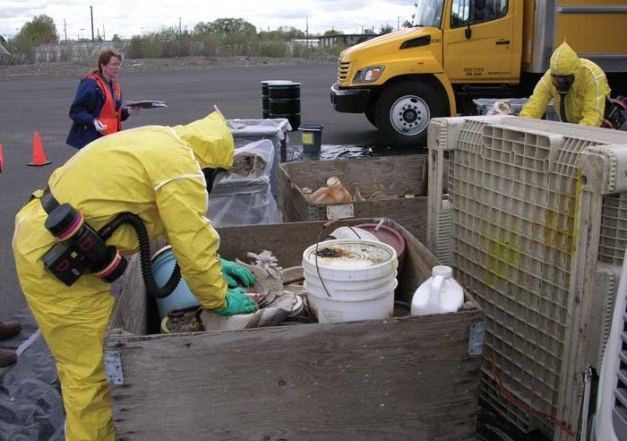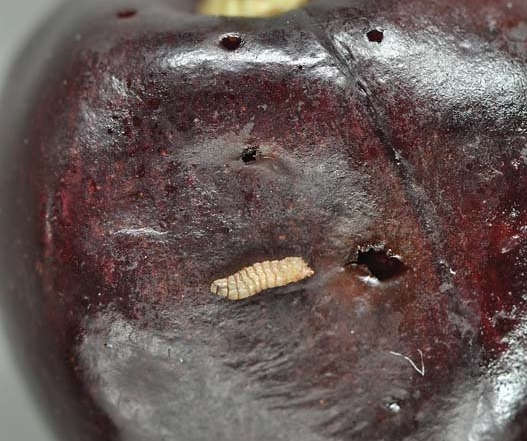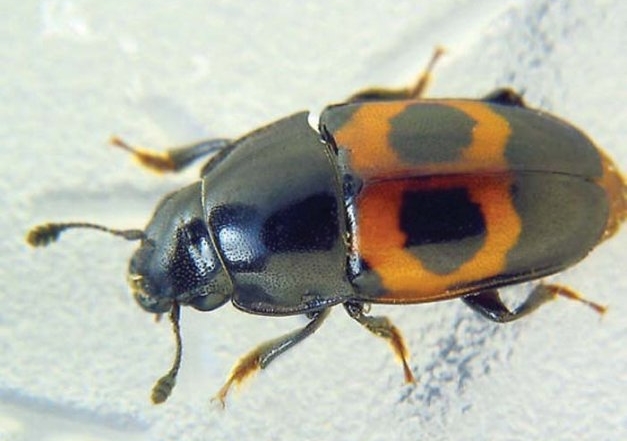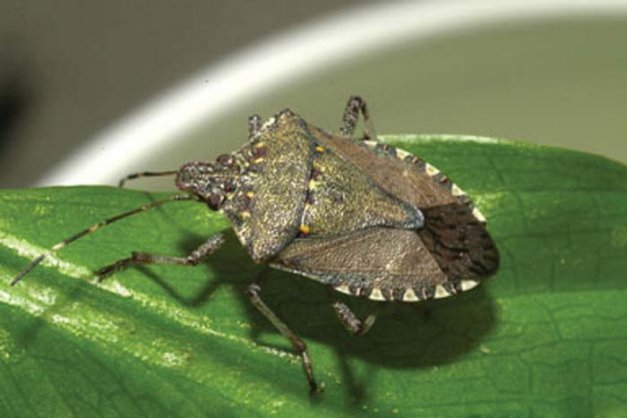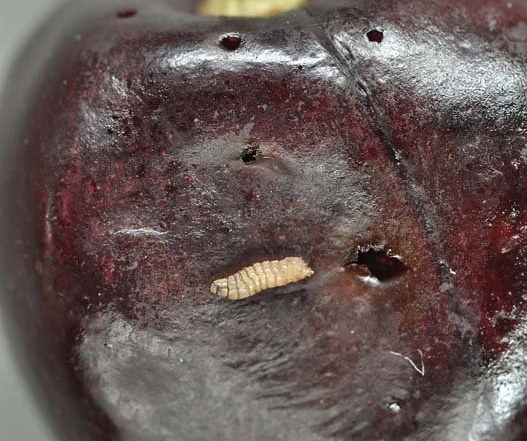Project Description
Pest Management
Featured stories covering pest management appear in this issue.
Old pesticides wanted
Bins should not be used for storing pesticides. The Department of Agriculture can bring all the necessary equipment to the farm to dispose safely of
Good Stuff
The Digi-Test is a new instrument for assessing the internal quality of apples. It probes deeper into the fruit than the standard Magness-Taylor firmness tester.
Defense strategies
Brown marmorated stinkbug nymphs develop through five instars, all feeding on fruit. Nymphs and adults cause both external and internal injury. Photo by Tracy Leskey
Grower battles bug
PHOTO BY TRACY LESKEY Gerrardstown, West Virginia, apple grower George Behling is one very concerned grower. He first saw this stinkbug two years
Ready for drosophila
Spotted wing drosophila larvae that hatch from eggs inside the fruit sometimes pop out and walk around on the surface. The spotted wing drosophila can
Play to win
Oregon State University agricultural economist Clark Seavert, pictured in a high-density pear trial block at Hood River, Oregon, says most growers are playing not to
A primer on Botrytis cinerea
Dr. Wayne Wilcox of Cornell University says Botrytis cinerea as a weak pathogen that prefers injured, senescent tissue, such as old blossom parts and ripening
Bunch rot strategy for 2011
PHOTO COURTESY OF CORNELL UNIVERSITY For Washington grape growers who had a bunch rot problem in 2010, efforts to get rid of any carryover crop
Botrytis comes to dry Washington
Latent infections inside a cluster can take over the bunch by harvest time.PHOTO COURTESY OF CORNELL UNIVERSITY Last year’s cool season not only
Will the new pest go after grapes?
Grape growers learn to identify spotted wing drosophila at a Washington State Grape Society meeting. Photo by Melissa Hansen Preliminary tests conducted last
Stinkbugs on the move
Adult brown marmorated stinkbugs feed on ripe peaches, a preferred fruit. A monitoring trap in a commercial apple orchard drew large numbers of bugs. Some
Cougarblight model updated
Washington State University is working to help growers be better prepared to fight fireblight. Washington State University’s Cougarblight model is being updated to improve its
Sap beetles attacked Michigan cherries
The strawberry sap beetle was one of three species identified in cherry orchards. The other two were dusky and picnic sap beetles. Photo by Stephen
Obliquebanded leafroller bugs tart cherry growers
Leafroller larvae form webs and use them to curl leaves into protective structures. Photo Courtesy Of Washington State University Obliquebanded leafroller has been increasing as
Researchers tackle apple weevil
Small and black, the apple flea weevil looks a bit like its larger snout beetle relative, the plum curculio. Photo by matt grieshop, michigan state
Rainfastness of pesticides varies
John Wise carries out his rainfastness work on grapes and apples at Michigan State University’s Trevor Nichols Research Complex, where he is coordinator of
New food safety law could swallow GAP programs
When provisions of the new food safety law (the American Food Safety Modernization Act) are implemented, Good Agricultural Practice (GAP) certification programs should wither away,
Buffers would make orchards vulnerable
If no-spray buffers proposed by the U.S. Environmental Protection Agency go into effect, orchardists will be unable to use critical pesticides on a large proportion
Good Job
Jim and Rose King, at left, and John and Betsy King, right, pose with their award and the National Cherry Queen Maria LaCross, who hails
Old pesticides wanted
Bins should not be used for storing pesticides. The Department of Agriculture can bring all the necessary equipment to the farm to dispose safely of
Good Stuff
The Digi-Test is a new instrument for assessing the internal quality of apples. It probes deeper into the fruit than the standard Magness-Taylor firmness tester.
Defense strategies
Brown marmorated stinkbug nymphs develop through five instars, all feeding on fruit. Nymphs and adults cause both external and internal injury. Photo by Tracy Leskey
Grower battles bug
PHOTO BY TRACY LESKEY Gerrardstown, West Virginia, apple grower George Behling is one very concerned grower. He first saw this stinkbug two years ago, but
Ready for drosophila
Spotted wing drosophila larvae that hatch from eggs inside the fruit sometimes pop out and walk around on the surface. The spotted wing drosophila can
Play to win
Oregon State University agricultural economist Clark Seavert, pictured in a high-density pear trial block at Hood River, Oregon, says most growers are playing not
A primer on Botrytis cinerea
Dr. Wayne Wilcox of Cornell University says Botrytis cinerea as a weak pathogen that prefers injured, senescent tissue, such as old blossom parts and ripening
Bunch rot strategy for 2011
PHOTO COURTESY OF CORNELL UNIVERSITY For Washington grape growers who had a bunch rot problem in 2010, efforts to get rid of any carryover crop
Botrytis comes to dry Washington
Latent infections inside a cluster can take over the bunch by harvest time. PHOTO COURTESY OF CORNELL UNIVERSITY Last year’s cool season not only challenged
Will the new pest go after grapes?
Grape growers learn to identify spotted wing drosophila at a Washington State Grape Society meeting. Photo by Melissa Hansen Preliminary tests conducted last fall indicate
Stinkbugs on the move
Adult brown marmorated stinkbugs feed on ripe peaches, a preferred fruit. A monitoring trap in a commercial apple orchard drew large numbers of bugs. Some
Cougarblight model updated
Washington State University is working to help growers be better prepared to fight fireblight. Washington State University’s Cougarblight model is being updated to improve its
Sap beetles attacked Michigan cherries
The strawberry sap beetle was one of three species identified in cherry orchards. The other two were dusky and picnic sap beetles. (Courtesy Stephen Luk)
Obliquebanded leafroller bugs tart cherry growers
Leafroller larvae form webs and use them to curl leaves into protective structures. Photo Courtesy Of Washington State University Obliquebanded leafroller has been increasing as
Researchers tackle apple weevil
Small and black, the apple flea weevil looks a bit like its larger snout beetle relative, the plum curculio. Photo by matt grieshop, michigan state
Rainfastness of pesticides varies
John Wise carries out his rainfastness work on grapes and apples at Michigan State University’s Trevor Nichols Research Complex, where he is coordinator of research.
New food safety law could swallow GAP programs
When provisions of the new food safety law (the American Food Safety Modernization Act) are implemented, Good Agricultural Practice (GAP) certification programs should wither away,
Buffers would make orchards vulnerable
If no-spray buffers proposed by the U.S. Environmental Protection Agency go into effect, orchardists will be unable to use critical pesticides on a large proportion
Good Job
Jim and Rose King, at left, and John and Betsy King, right, pose with their award and the National Cherry Queen Maria LaCross, who hails

